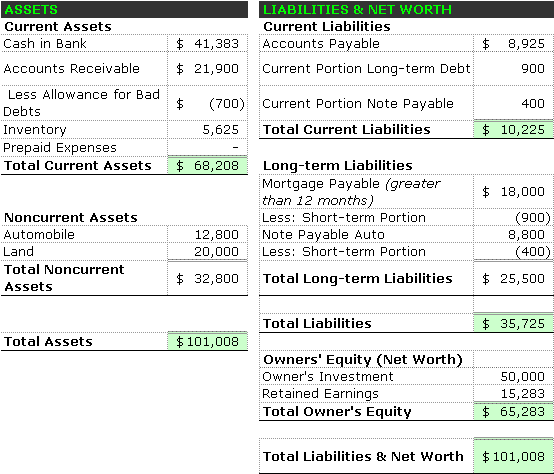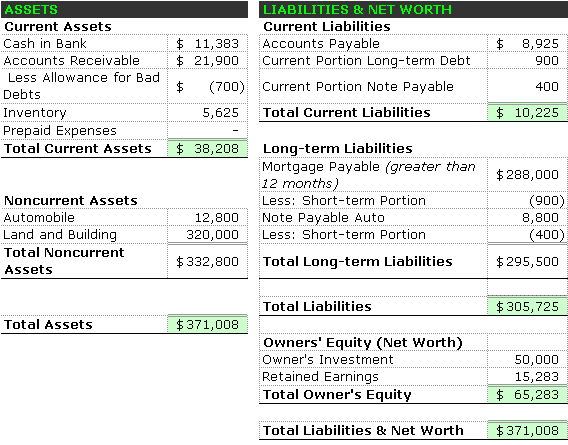Balance Sheet Analysis
| Balance sheet analysis primarily includes measuring three key accounting formulas: working capital, the current ratio, and the quick ratio. |
One of the most important measures to consider in financial statement analysis is whether or not the business can pay debts to remain in operation. The current ratio, quick ratio, and working capital can quickly assess a company’s short-term financial strength. This is especially important since the profits of the business do not accurately reflect cash on hand.
Under the accrual accounting method, the revenue is recognized when earned, whether or not cash is received as payment. Since sales may be on credit, even profitable companies may be at risk due to too much debt or a shortage of liquid assets.
Therefore, applying financial ratios and accounting formulas to the company balance sheet offers a quick way to assess the actual short-term liquidity and strength of the business.
Now let’s take a look at applying working capital, the current ratio, and the quick ratio to the company balance sheet for Sunny Sunglasses Shop to assess its liquidity and financial strength.
Balance Sheet Analysis
Sunny Sunglasses Shop
Company Balance Sheet
December 31, 2012
Working Capital
| 68,208 – 10,225 = 57,983 |
The working capital number is more than enough to pay down current liabilities coming due. Cash alone can easily cover the current liabilities. Of course, this may be an indication that Sunny Sunglasses has too many resources that can contribute to growth sitting in cash. Cash and accounts receivable are also pushing the current ratio and quick ratio substantially above the industry averages.
Current Ratio
| 68,208/10,225 = 6.7 |
Quick Ratio
| (68,208 – 5,625)/10,225 = 6.1 |
Notice that the quick ratio removed inventory from the calculation, as inventory is not considered a “quick asset” quickly convertible to cash. Prepaid expenses would also be removed, but the balance was zero by the end of the year.
The second accounting formula, the current ratio, is high due to high receivables and cash amounts.
The quick ratio did not make a significant difference because inventory has a lower balance compared to the other current assets. Is inventory too low? As a new business owner, Sunny closely monitors his inventory to determine which models sell the fastest, and has not maintained high inventory levels as new models are arriving for the summer season. Maintaining inventory levels that are too low, however, can have a negative impact on sales.
To determine whether or not the inventory levels are adequate for Sunny Sunglasses Shop, click inventory turnover.
The higher than normal cash balance is due to the owner preparing to finance a new building on the land purchased for $20,000 for future use.
If the company financed a new building for $300,000, with a $30,000 down payment, the balance sheet accounts and accounting ratios would be affected as follows:
Balance Sheet Analysis
Sunny Sunglasses Shop
Company Balance Sheet
December 31, 2012
In the second example of balance sheet analysis, note that the cash balance of $30,000 has transferred from current assets to noncurrent assets: land and building, contributing $30,000 to the balance. The remaining $270,000 came from a new mortgage for the building. Assuming no current amount is due on the new mortgage, noncurrent assets increased by $300,000, long-liabilities increased by $270,000, and current assets decreased by $30,000 due to the cash down payment.
As a reminder, this affects the accounting equation as follows:
| Assets = | Liabilities | + Owners Equity | |
| Cash <$30,000> | Land and Building $300,000 | $270,000 | $0 |
The Working Capital Accounting Formula changed accordingly:
Working Capital:
| 38,208 – 10,225 = 27,983 |
Sunny Sunglasses Shop still has plenty of current assets to cover current liabilities coming due.
The current ratio and quick ratio are changed to:
New Current Ratio:
| 38,208/10,225 = 3.7 |
New Quick Ratio:
| (38,208 – 5,625)/10,225 = 3.2 |
This use of cash for financing a building for future growth has lowered the current ratio and quick ratio substantially, but remains higher than the industry average. Though this is not as significant of an issue as lower than normal current and quick ratios, Sunny should next look into whether or not accounts receivable turnover is too low.
Back from Balance Sheet Analysis to the Accounting Balance Sheet Main Page



I would like to know if there’s any non-ratio analysis one can make on a Balance sheet.